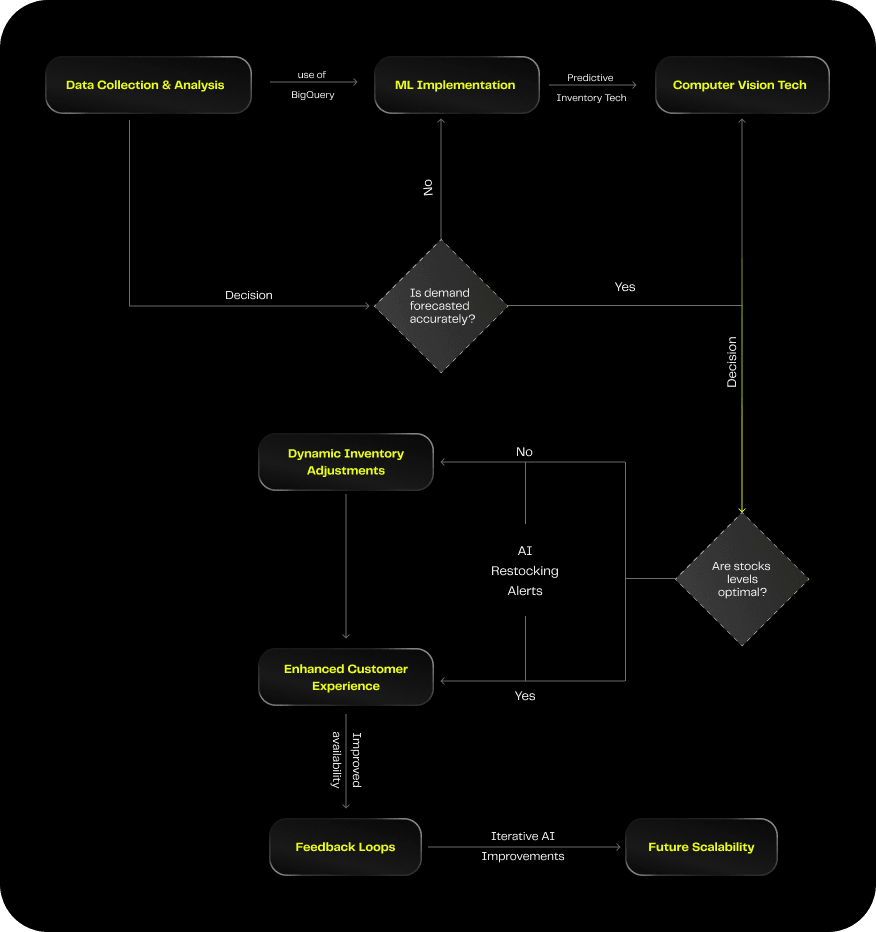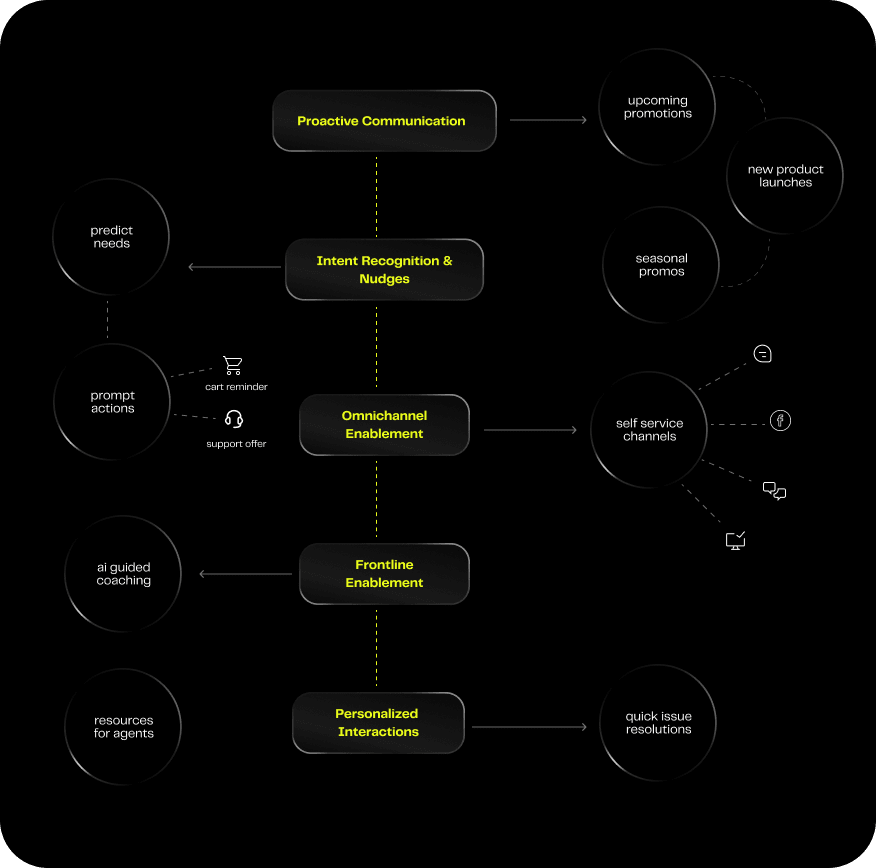AI in Retail: How Retailers Are Using AI to Optimize Omnichannel Operations
Retail is ground zero for the impact of AI, and the largest players are already making it a core part of their gameplan for this decade.
This would be obvious to anyone who has read the headlines, skimmed the reports, and maybe even tested a few AI pilots. But while some of them are still cautiously exploring, leaders like eBay, Walmart, and Nordstrom have gone all in—embedding AI deep into their operations.
And it’s paying off. According to McKinsey, AI is poised to unlock between $240 billion to $390 billion in economic value for retailers. Meanwhile, the global AI in retail market is set to grow from $9.36 billion in 2024 to a staggering $85.07 billion by 2032, driven by innovations like AI-powered search and chatbots.
Why should you care?
Because AI is no longer just a promising concept—it’s driving retail transformation right now. From converting mountains of unstructured data into actionable insights to automating logistics, AI is rewriting the rules of omnichannel success.
The mandate is clear—deploy AI where it counts to drive measurable outcomes.
Here are 3 pivotal areas where AI is making a real difference.
1. Omnichannel Inventory Management
Managing inventory across multiple channels has always been a delicate balancing act because fluctuating demand, stockouts, and surplus inventory can chip away at margins while also frustrating customers. The challenge lies in maintaining a unified, real-time view of inventory and without it, retailers risk missed sales, poor forecasting and operational inefficiencies.
Here’s how AI is rewriting the playbook.
Demand-Driven Inventory Optimization
AI significantly reduces the guesswork of inventory management. By analyzing seasonal trends, demand signals, and supplier lead times, it helps optimize stock levels with greater precision. This approach reduces the risk of overstocking or understocking, balancing costs and customer satisfaction.
- Smarter Reorder Points: AI can suggest more accurate reorder timings, potentially lowering carrying costs, which vary by industry.
- Real-Time Demand Sensing: By capturing demand fluctuations as they happen, AI helps retailers respond promptly to stock reallocations, helping them minimize costly out-of-stock scenarios—saving them an average of $1.1 million annually in lost sales.
Supplier Coordination for Faster Lead Times
Supplier relationships are critical, but traditional methods often rely on reactive decision-making. AI shifts this dynamic, offering predictive insights to streamline procurement and improve lead times.
- Lead Time Analytics: AI leverages historical data to predict supplier lead time variations, enabling retailers to adjust procurement strategies more proactively. However, just-in-time inventory depends on both accurate forecasts and supply chain flexibility.
- Automated Procurement Alerts: Integrated with supplier systems, AI generates timely restocking alerts, helping reduce the likelihood of supply chain disruptions. The effectiveness of these alerts, however, depends on data integration quality and supplier responsiveness.
This improved coordination boosts supplier responsiveness and reduces carrying costs by 20-30%, enhancing overall operational efficiency.
Strategic Stock Allocation Through Segmentation
Not all products should be treated equally. AI segments inventory by profitability, sales velocity, and customer preferences.
- AI-Driven Inventory Segmentation: AI segments inventory by factors like profitability, sales velocity, and customer preferences, enabling more tailored inventory management strategies.
- High-Margin Prioritization: Prioritize restocking for fast-moving, high-margin products to better capture demand.
- Dynamic Stock Allocation: AI can recommend adjustments to inventory distribution across regions and channels based on performance data.
This level of precision helps retailers avoid revenue loss from stockouts, which can erode up to 4% of revenue, while keeping inventory lean and effective.
Optimizing Returns and Reverse Logistics
Returns are inevitable but AI transforms them from a logistical headache into an opportunity.
- Predictive Returns Management: AI forecasts return rates, enabling seamless reverse logistics workflows.
- Cost-Effective Restocking: Returned items are quickly evaluated and reintegrated into inventory where feasible, minimizing waste and operational costs.
If effectively implemented, this helps retailers not only recoup value from returns but also improve the overall customer experience.
How Home Depot improved their inventory accuracy
Holding on to excess inventory isn’t just an inconvenience—it’s a profit killer. Excess inventory levels can erode annual profits by as much as 30%, tying up capital and storage space.
With over 2,200 stores, Home Depot faced a similar challenge—maintaining accurate inventory levels across multiple channels without straining resources. They turned to AI to tackle the problem head-on.
Here’s what they achieved:
-
Real-time Inventory Visibility: By integrating AI-powered analytics, Home Depot gained real-time insights into inventory levels. This led to a 15% improvement in stock accuracy, reducing both overstock and stockout situations—a win for their margins and customer satisfaction alike.
-
Precision Demand Forecasting: Leveraging machine learning models, Home Depot refined its demand forecasting capabilities. This meant better stock allocation, ensuring that products were available exactly where and when customers needed them.
-
Optimized Replenishment Schedules: With AI-driven insights, replenishment schedules were streamlined. This improved inventory distribution across channels, cutting delays and maximizing product availability.
The result? A leaner, more efficient inventory system that freed up capital, enhanced the customer experience, and set a new standard for omnichannel excellence.
 How The Home Depot leverages AI for dynamic Inventory adjustments
How The Home Depot leverages AI for dynamic Inventory adjustments
💡 AI enables retailers to track profitability by product and channel with a level of granularity not previously possible. This means resources can be allocated precisely where they generate the highest returns— helping retailers make smarter investment decisions that align with current demand and long-term growth.
2. Scaling Personalized Marketing
The modern customer journey is anything but linear. A single purchase might span weeks of touchpoints—browsing today, engaging next week, and buying a month later. These interactions generate a wealth of data, but acting on it in real-time remains a challenge.
According to Salesforce, 56% of customers expect offers to be personalized, yet only 29% feel they receive tailored experiences. This gap is costly—80% of consumers are more likely to switch brands after just one poor interaction.
AI enables marketers to deliver hyper-relevant experiences at scale:
- Predictive Personalization: AI anticipates customer needs by analyzing past behaviors, browsing habits, and external triggers like local events. Picture this: a regular buyer of running gear gets personalized recommendations for the latest arrivals or exclusive discounts—timed perfectly before their next shopping spree.
- Real-Time Adaptation: Customer preferences shift, and AI ensures your messaging evolves with them. Dynamic content updates keep your campaigns fresh and engaging, ensuring customers receive the right message at the right time.
- Cross-Channel Synchronization: Whether your customer is browsing online, scrolling through social media, chatting with the support team or walking into a store, AI unifies their experience. The result? Consistent messaging and seamless interactions across all touchpoints.
- Contextual Awareness: Real-time factors like weather or local events add an extra layer of relevance. Think cozy sweaters promoted during an unexpected cold snap—a simple nudge that boosts conversions.
Sephora’s AI-driven Personalization in Action
Sephora’s Virtual Artist app is a masterclass in AI-driven personalization.
Using advanced computer vision, customers can virtually try on makeup and receive recommendations based on their skin tone and preferences.
Their ‘Store of the Future’ concept takes this further, with AI-powered skin analysis devices offering detailed skincare insights and curated product suggestions.
The results speak for themselves:
- Higher Engagement: Interactive and experiential shopping keeps customers hooked.
- Reduced Returns: Personalized recommendations lead to informed purchases, cutting down returns.
- Improved Satisfaction: A seamless blend of convenience and hyper-personalization boosts customer loyalty.
💡 Beyond isolated campaigns, AI-driven personalization redefines the customer journey. By tailoring every touchpoint, retailers can foster deeper connections, build trust, and inspire long-term loyalty.
3. Enhancing Customer Experience
Today’s customers have zero tolerance for slow & generic interactions. They expect instant, personalized support across every touchpoint. Yet many retailers still lean on outdated FAQ bots that deflect rather than resolve issues —missing key opportunities to build trust and loyalty.
The stakes are high: 77% of B2B buyers are comfortable spending $50,000 or more online, with 35% willing to exceed $500,000 in a single transaction. For these high-value buyers, subpar service isn’t just a minor annoyance; it’s a dealbreaker.
 How AI supports each step of the customer service process: McKinsey’s State of Customer Care
How AI supports each step of the customer service process: McKinsey’s State of Customer Care
AI-powered chatbots and virtual assistants bridge this gap by:
- Breaking down silos: Historically, marketing, sales, and service teams operated in isolation, leading to fragmented customer experiences. AI integrates data across these departments, creating a unified customer profile that ensures consistent, personalized interactions at every touchpoint.
- Expanding automation: Traditional tools like IVR, agent assist, and basic chatbots have improved efficiency but AI, powered by LLMs, takes automation further. These advanced systems handle complex inquiries —whether it’s troubleshooting product issues or managing account preferences—reducing wait times and enhancing satisfaction.
- Proactive Engagement: AI doesn’t just react; it anticipates. For instance, if a customer abandons their cart, AI can step in with personalized assistance or exclusive incentives. This not only recovers lost sales but also enhances the overall experience by demonstrating attentiveness.
- Multi-channel consistency: Whether a customer begins their journey online, visits a physical store, or contacts support, AI ensures a seamless experience. Store associates can access a customer’s interaction history, enabling more meaningful, informed conversations.
- Post-purchase Personalization: The customer journey doesn’t end at checkout. AI delivers personalized follow-ups, from recommending complementary products to sharing real-time order updates or assisting with returns. This reinforces the brand’s commitment to ongoing customer care.
💡_According to McKinsey's State of Customer Care report, nearly 50% of customer inquiries are now managed by AI-driven chatbots. These tools don’t just resolve issues faster; they set a new standard for omnichannel consistency, proactively building trust and boosting satisfaction._
If you're not sure where to begin your internal transformation, we understand.
Our consultants can help you take the first step to smarter, faster, and more personalized omnichannel success.
Drop us a line at hello@coderapper.com to get started—or stay tuned for our next piece, where we’ll share a quick roadmap on integrating AI effectively into your omnichannel operations.








